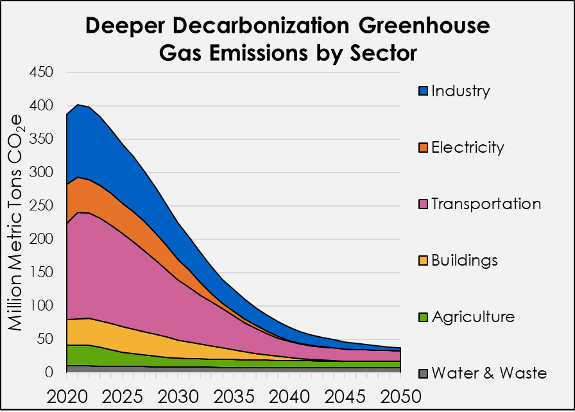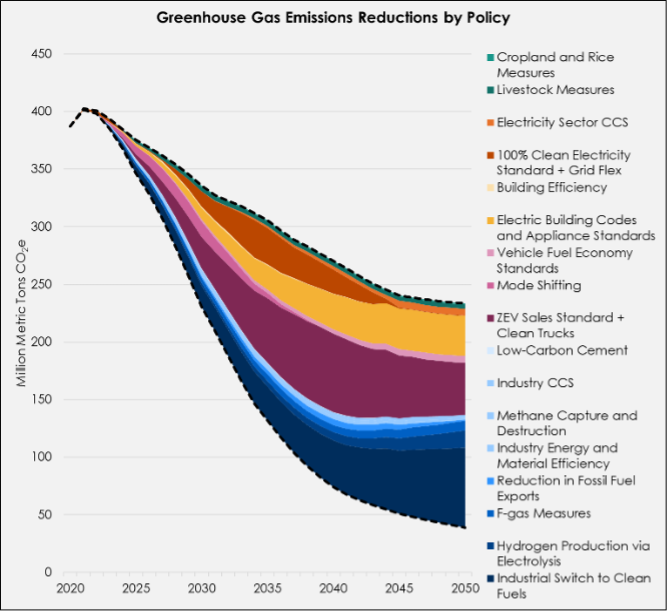By Olivia Ashmoore
This week, Energy Innovation released new research evaluating California’s climate progress and identifying a policy pathway that would reaffirm California as a climate leader. This modeling showed the state is off track for its 2030 and 2045 climate goals, and must triple its historic emissions reduction pace. Doing so would generate billions in new GDP and hundreds of thousands of new jobs statewide.
Energy Innovation used the California Energy Policy Simulator (EPS) to identify a “Deeper Decarbonization Scenario” and compare it to modeling for the California Air Resources Board’s (CARB) 2022 Draft Scoping Plan.
The Deeper Decarbonization Scenario shows California can rapidly cut greenhouse gas (GHG) emissions while creating jobs and improving public health. The updated California EPS–from model version 1.4.3 to 3.3.1–includes important new metrics to track the economic, environmental, and public health impacts of hundreds of climate policies.
CARB is currently evaluating climate policies for its 2022 update of the Climate Change Scoping Plan. Under the state’s landmark AB 32 climate law, CARB is required to evaluate the state’s progress toward its goals and make recommendations every five years. This year’s Draft Scoping Plan proposes a pathway to achieve the state’s target of 40 percent emissions below 1990 levels and economy-wide carbon neutrality by 2045.
Unfortunately, the Draft Scoping Plan leans on unproven carbon removal technologies as a way to reach carbon neutrality, instead of proven strategies like renewable energy paired with electrification of vehicles, buildings, and industry to secure large near-term emissions reductions.
The newly updated California EPS can help state policymakers design policies and programs that swiftly cut harmful emissions while maximizing economic and health co-benefits. To inform the Draft Scoping Plan, Energy Innovation used the California EPS to model three policy scenarios and show effects on emissions, the economy, and public health.
The Business As Usual (BAU) Scenario represents California’s existing climate policies, including building efficiency improvements, new building electrification, electric vehicle (EV) adoption, carbon pricing, a reduction in short-lived climate pollutants, and a clean electricity standard.
The Committed Policy Scenario includes executive orders or specific proposals not yet fully backed by established in law or regulation. This scenario includes BAU policies as well as a higher carbon price, vehicle electrification, and mode shifting (shifting from vehicle to active and public transportation).
The Deeper Decarbonization Scenario—developed by Energy Innovation—shows a holistic, cost-effective policy pathway that reduces emissions in the buildings, industry, transportation, and electricity sectors. This scenario highlights policies that achieve 47 percent emissions reductions below 1990 baseline emissions by 2030 and 89 percent reduction by 2045. This scenario relies on already mature technologies to achieve near-term emissions reductions, as opposed to nascent technologies such as carbon removal.
EPS modeling results show that stronger climate policies create significant economic, employment and public health benefits. The Deeper Decarbonization Scenario creates 170,000 jobs in 2030 and 115,000 in 2045, and adds $28 billion to the state economy in 2030 and GDP is $5.1 billion higher than business-as-usual in 2045.
This policy package also avoids approximately 1,300 premature deaths due to air pollution in 2030 and 3,900 deaths in 2045.
Some of the most impactful policies will actually save money. The EV sales standard (-$527/ton), building electrification (-$29/ton), and the industry efficiency standards (-$1,084/ton) all have a net-negative cost—meaning the fuel cost savings over the lifetime of the policy offset the upfront capital costs.
Business-as-Usual Scenario and Policy Commitments Scenario
California has the United States’ second-largest state GHG footprint and is not on track to cut emissions in line with its climate goals. The transportation sector made up the largest share of emissions (37 percent), followed by industry (27 percent). Electricity accounted for 15 percent of emissions, buildings 10 percent, agriculture 8 percent, and water and waste 3 percent.
Under the BAU Scenario California would only cut emissions 45 percent (from 1990 baseline) by 2045–far from the 2022 Scoping Plan’s carbon neutrality by 2045 target. The annual emissions reductions would need to more than triple over the next two decades to achieve carbon neutrality.

The Committed Policy Scenario includes a broader array of policies beyond the BAU policies with clear statutory authority and enforceability. The Committed Policy Scenario evaluates the combined emissions effects of what policymakers have indicated they want to do, even if the policy approach is not yet clear or backed by law.
This includes CARB’s current proposal for changes to its Advanced Clean Cars program, electrification of heavy-duty trucks, improved mode shifting and fuel efficiency, and a higher carbon price that extends beyond 2030. By 2030, emissions are 29 percent lower than 1990 emissions and 63 percent lower by 2045. In this scenario, the majority of emissions reductions come from the transportation policies.
Deep Decarbonization Scenario Results
The Deeper Decarbonization Scenario aims for deep emissions reductions by 2030, well ahead of the 2045 state target. The scenario reduces emissions 47 percent by 2030 (from 1990 baseline) and 89 percent by 2045.
The Deeper Decarbonization Scenario does not quite get California to net-zero emissions by 2045. This is partially due to uncertainty about future available technology to cut industrial emissions and continued global demand for fossil fuels. CARB’s Scoping Plan Scenario reaches carbon neutrality by relying heavily on uncertain technologies to extract almost 80 million metric tons of carbon dioxide equivalent from the atmosphere in 2045.

Instead of betting its future on risky strategies further down the road, California should rely on guaranteed pollution-fighting climate actions to lock in near-term reductions and a safer future.
Top Emissions Reducing Policies
California’s 2045 net-zero goal leaves the state with just 23 years to switch the state’s fuels from fossil to clean electricity and zero-carbon fuels. Because building appliances, vehicles, and industrial equipment only need replacement every 10 to 20 years, policymakers have a short window to enact policies that require a transition from fossil to zero-carbon fuels. The Deeper Decarbonization Scenario includes policies to rapidly electrify the building and transportation sectors, sets critical efficiency and fuel switching standards for industry, requires a zero-carbon electricity grid, and draws down process emissions from industry and agriculture.

The most impactful policies are the zero-emission vehicle sales standard (29 percent of scenario emissions), industrial fuel switching to electricity and hydrogen (24 percent of scenario emissions), and the building electrification policy (15 percent of scenario emissions).
A 90 percent by 2030 clean electricity standard compounds emissions reductions because of growing electricity use from economy-wide electrification.
Comparison to Scoping Plan
Compared to CARB’s 2022 Scoping Plan Scenario, the Deeper Decarbonization Scenario emphasizes earlier action with existing clean technologies, such as switching cars and buildings to electricity, which is the most easily decarbonized modern energy source. In contrast, the Scoping Plan Scenario leans more heavily on carbon dioxide removal technology, deploying both carbon capture and sequestration at industrial plants and direct air capture, a technology which pulls carbon dioxide out of the atmosphere.
Economic and Health Benefits of Deeper Decarbonization Scenario
The Deeper Decarbonization Scenario also shows adopting stronger climate policies provides an opportunity for California to grow its economy, create jobs, and improve air quality for all residents.
The state-level input-output analysis embedded in the California EPS estimates this scenario would create roughly 170,000 jobs in 2030 and 115,000 new jobs in 2045. State GDP grows to $28 billion above the BAU value in 2030, and is $5.1 billion higher than business-as-usual in 2045.

Additional policies not modeled by the EPS would be necessary to ensure new economic growth benefits communities historically reliant upon, or harmed by the fossil fuel economy, with high-quality jobs paying fair wages.
The Deeper Decarbonization Scenario also generates significant health benefits. The California EPS, which includes a simple assessment of these benefits based on regional emissions factors by fuel and end-use, estimates the Deeper Decarbonization Scenario policies would prevent approximately 1,300 premature deaths due to air pollution in 2030 and 3,900 fewer deaths in 2045. The scenario would also prevent 26,600 asthma attacks in 2030 and 77,000 asthma attacks in 2045. Better air quality and a safer climate would also save $21 billion in 2030 and $56 billion in 2045.
On a percent change basis, avoided deaths are greater for people of color. The percentage reduction in premature deaths is about double for people identifying as Asian, Latino, or ‘other race’ compared to people identifying as white. These estimates were developed using data from the U.S. Environmental Protection Agency on the health incidents that occur or are avoided per ton pollutant.
Conclusion
California has ambitious decarbonization goals, but is not on track to reach these targets. California EPS modeling shows that adopting a strategic set of climate policies will achieve a rapid transition to clean energy that will create thousands of new jobs, add billions to the state’s economy, and improve health. Acting now will ensure all residents and future generations of Californians will benefit from a growing economy and a safer climate.